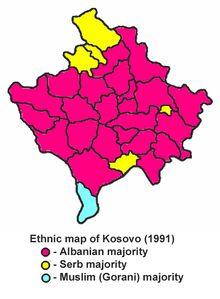Gora (region)
| Gora | |
|---|---|
| Geographical and historical region | |
 | |
| Countries |
|
| Area | |
| • Estimate | 500 km2 (200 sq mi) |
| Population | |
| • Estimate (2011) | 40,000 |
| • Density | 80/km2 (200/sq mi) |

Gora (Cyrillic: Гора) is a geographical region in southern Kosovo, northeastern Albania, and northwestern Macedonia inhabited by Albanians, Bosniaks, Gorani, Macedonians, and Turks. The name "Gora" is a Slavic word for "mountain" or "forest".
Between 1992 and 1999, the part of Gora in Kosovo was a municipality, and its population was 17,574 people according to the 1991 census. Today, the region is part of the municipality of Dragaš in Kosovo. The Albanian part of Gora is included in the Shishtavec and Zapod municipalities, while the Macedonian portion is in the northeastern part of Bogovinje Municipality.
In the west of Gora is the region of Lumë, which extends in both Kosovo and Albania.[1]
History
The Ottoman defter from 1591 registers Gora as inhabited exclusively by Serbs, Opolje to the north is Albanian populated.[2]
Geographical distribution
Albania
According to the disputed 2011 census figures, just over two-thirds of the population in Shishtavec Municipality identified as Albanian, while 7.7% identified as Macedonian. In Zapod Municipality, 79% identified as Albanian and 11.7% identified as Macedonian.[3]
Kosovo
According to 1991 census data, the population of the Gora municipality was composed of:
Kosovo's Gorani people have stated that they want the former Gora municipality with a Gorani majority that was merged with the Albanian-majority Opolje to form the Dragaš municipality which has an Albanian majority) to join the Community of Serb municipalities. On 3 November 2013, 70% voted in favour of establishing the Gora municipality as part of the Community of Serb municipalities, according to Gorani political leader Safet Kuši.[6]
Macedonia
Jelovjane, one of Macedonia's two Gora villages, according to the 2002 census, was made up primarily of Turks (90%). The other Gora village, Urvič, was made up of Turks (85%) and Albanians (15%).[7]
References
- ↑ Fejzulla Gjabri (Department of Culture of Albania), Information about the Heroic Epos in the Province of Luma
- ↑ TKGM, TD № 55 (412), (Defter sandžaka Prizren iz 1591. godine).
- ↑ "Ethnic composition of Albania 2011". Retrieved 7 August 2014.
- ↑ OSCE
- ↑ "municipal profile of Dragaš" (PDF)., June 2006. Retrieved on 21 February 2008.
- ↑ "Goranci: Ne želimo u Dragaš već u Zajednicu srpskih opština" (in Serbian). Blic. 2013-11-08.
- ↑ Macedonian census, language and religion
External links
- Gora 1968 part 1 - Short Documentary film about Gora
- Gora 1968 part 2 - Short Documentary film about Gora
| Wikimedia Commons has media related to Gora (region). |
Coordinates: 41°58′41″N 20°39′25″E / 41.978°N 20.657°E